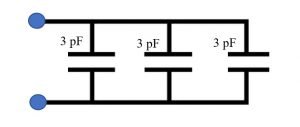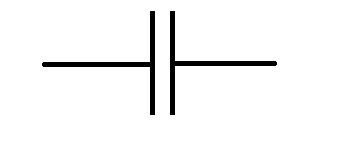1. A capacitor has a voltage difference of 10 V across the plates. It has stored charges of 1000 micro-coulombs. What is the capacitance value?
- 100 μF
- 10 pF
- 0.01 μF
- 100 pF
Solution: (1). 100 μF.
Answer Hints: We know that capacitance is given as C = Q / V
Q is the amount of charges stored by the capacitor. V is the voltage in between the plates.
Using the equations, we get – C = (1000 * 10 -6) / 10 = 100 μF
Click here for Concept of Capacitor!
2. The plates of parallel plate capacitor is right angle in shape. Two sides of them are 2 cm in size. The distance in between two plate given as: 0.1 cm. What will be the capacitance value if the permittivity of the dielectric is 10-11 F/m?
- 1 x 10-14 F
- 2 x 10-12 F
- 2 x 10-14 F
- 1 x 10-12 F
Solution: (2). 2 x 10-12 F. Try to solve without using the hints!.
Answer Hints: The formula of capacitance is given as-
C =ε A/ d
Here C is the capacitance, ε Refers to the medium’s permittivity. d is the distance. The side of the triangles is – 2cm or 0.02m.
The surface area= ½ * 0.02 * 0.02 = 2×10-4
ε = 10-11 F/m d = 0.001m
So, C = 2 x 10-12 F
3. Find out the equivalence capacitance.

- 1/3 pF
- 1 pF
- 3 pF
- 9 pF
Solution: (4). 9pF.
Answer Hints: As we can see that The connection is in parallel..
The equivalent parallel capacitance is stated as Ceq = C1 + C2 + C3 + … + CN
So, the equivalent capacitance is = 3+3+3 = 9 pF
4. Find out the equivalence capacitance of the circuit.

- 1/3 pF
- 1 pF
- 3 pF
- 9 pF
Solution: (2). 1 pF.
Answer Hints: As we can see, the capacitors are in series connection.
The equivalent series capacitance is stated as 1 / Ceq = 1 / C1 + 1 / C2 + 1 / C3 + … + 1 / CN
So, the equivalent capacitance is = 1 / (1 / 3+1 / 3+1 / 3) = 3/3 = 1 pF
5. A capacitor has a capacitance value of 1 micro-farad. What does it imply?
- It stores one coulomb of charge
- It holds 6.24 x 1012 electrons
- It stores one volt
- It stores one A of current
Solution: (2). It holds 6.24 x 1012 electrons.
6. What is the effect on capacitive reactance values if the capacitors are connected in series?
- An increase in total Xc
- A decrease in real Xc
- No change in real Xc
- Reactance does not depend on connectivity.
Solution: (1). An increase in total Xc
7. How an electrostatic field varies if the charge difference is given?
- Plate differential
- Plate Distance
- Dielectric Quantity
- Plate Area
Solution: 4). Plate Area
8. How the capacitance of a parallel plate capacitor can be decreased?
- Increasing the gap between the plates
- If the charge of the capacitor is increased.
- Decreasing the gap between the plates
- If the charge of the capacitor is decreased.
Solution: (1). Increasing the gap between the plates
9. A capacitor and an output resistor are connected in series. The circuit will function like –
Solution: (4). High pass filter.
10. Which type of material is used between the plates of the capacitor?
- Diodes
- Materials with high impedance
- Plate divider material
- Dielectric Material
Solution: (4). Dielectric material.
11. Which material has the highest dielectric value in the below options?
- Mica
- Air
- Paper
- Wood
Solution: (1). Mica
12. What is the phase difference for voltage and current in a capacitor only circuit?
- The voltage lead by 90 degrees
- The current lead by 90 degrees
- The voltage lag by 180 degrees
- The voltage and current has no phase differences.
Solution: (2). The current lead by 90 degrees.
13. What is the effect on capacitance if the dielectric constant is decreased?
- It remains the same
- It increases
- It decreases
- The capacitor does not function.
Solution: (3). It decreases
14. Which of the following is true about capacitor?
- C = Q / V
- V = Q * C
- C = R * I
- Q = I / V
Solution: (1). C = Q / V
15. What is the S.I. unit of capacitor?
- Henry
- Ohm
- Volt / Amp
- Farad
Solution: (4) Farad
16. What is the value of the Q factor of a capacitor?
- Q = 1 / RC
- Q = 1 / (RC)1/2
- Q = 1 / ωCR
- Correct option is not given
Solution: (3). 1 / ωCR
17. What is the capacitor’s time constant?
- τ0 = 1 / C
- τ0 = RC
- τ0 = 1/RC
- τ0 = C
Solution: (2). τ0 = RC
18. Comment Truth or False based on the sentence given.
Statement: Air can serve as the dielectric for the capacitor.
- True
- False
Solution: (1). True
19. What is dissipation factor for a ceramic capacitor?
- tan δ = ESR * ωC
- tan δ = ESR * 1 / C
- tan δ = 1 / (ESR * ωC)
- tan δ = ESR * C
Solution: (1). tan δ = ESR * ωC
What is dissipation factor? Click to Know!
20. What type of ceramic capacitor provides higher stability?
- Class 1 type
- Class 2 type
- Ceramic Disc Capacitor
- MLCC
Solution: (1). Class 1 type
21. Which dielectric is used for tantalum metal?
- Tantalum Aluminium Di-Oxide
- Tantalum Niobium Phosphide
- Tantalum pentoxide
- Tantalum phosphide
Solution: (3). Tantalum pentoxide
22. Which type of capacitor has the highest CV product?
- Ceramic capacitor
- Tantalum electrolytic capacitor
- Coupling capacitor
- bypass capacitor
Solutions: (2). Tantalum Electrolytic capacitors.
Know everything about Tantalum Electrolytic Capacitors…Click to proceed….
23. What is surge voltage?
- The minimum voltage received from the load.
- The maximum voltage received from the load.
- The maximum peak voltage applied.
- The minimum peak voltage applied.
Solution: (3). The maximum peak voltage applied.
24. Comment Truth or False based on the sentence given.
Statement: Capacitors are polarized.
- True
- False
Solution: (1). True
25. How much energy will be stored in a capacitor if the applied voltage is V?
- ½ CV2
- ½ CV
- CV2
- 1/4 CV2
Solution: (1). ½ CV2
How energy is being stored in a capacitor? Click for answer!
26. Condenser is currently known as –
- Filters
- Rectifiers
- Capacitors
- Diodes
Solution: (3). Capacitors
27. How the impedance of a capacitor is represented in Laplace transform?
- Z(s) = s / C
- Z(s) = 1 / sC
- Z(s) = 1 / s2C
- Z(s) = S2 / C
Solution: (2). Z(s) = 1 / sC
28. What will be the effect of increasing the electrode area of a plate capacitor?
- The capacitance remains the same.
- The energy stored by the capacitor gets decreased.
- The capacitance value gets reduced.
- The energy stored by the capacitor gets increased.
Solution: (4). The energy stored by the capacitor gets increased.
29. Which of the following is the symbol for a bipolar dielectric capacitor?

Solution: (4).
30. Which organization gives the standardization for all electrical components, including capacitors?
- IEEE(Institute of Electrical and Electronics Engineers)
- NMEA(National Marine Electronics Association)
- IEC(International Electrotechnical Commission)
- Correct option is not given.
Solution: (3).IEC (International Electrochemical Commission).
31. How quality factor is related with Dissipation Factor?
- Q = 1 / tan δ
- Q = 1 / tan2 δ
- Q = tan δ
- Q = 1 / ESR * tan δ
Solution: (1). Q = 1 / tan δ
32. Which type of capacitor provides high volumetric efficiency?
- Ceramic Capacitors of Class 1
- Ceramic Capacitors of Class 2
- Ceramic Capacitors of Class 3
- Ceramic Capacitors of Class 4
Solution: (2). Ceramic Capacitors of Class 2
33. How does frequency is related to the capacitance of a capacitor?
- An increase in the frequency will cause a increase in the capacitance.
- An increase in the frequency will cause a decrease in the capacitance.
- Increasing the frequency will not affect the capacitance.
- Decreasing the frequency will decrease the capacitance.
Solution: (2). An increase in the frequency will cause a decrease in the capacitance.
34. What is voltage proof for a ceramic capacitor?
- The surge voltage
- The applied voltage
- The load voltage
- The rated voltage.
Solution: (4). The rated voltage.
35. When does the resonance occurs in a ceramic capacitor?
- When the imaginary parts of the capacitor impedance and admittance cancel each other.
- When the imaginary parts of the capacitor impedance and admittance do not exist.
- When the imaginary parts of the capacitor impedance have a higher value than admittance.
- When the imaginary parts of the capacitor impedance have a lower cost than admittance.
Solution: (1) When the imaginary parts of the capacitor impedance and admittance cancel each other.
36. What is the dielectric absorption for a class 1 ceramic capacitor?
- 1% to 3%
- 7% to 9%
- 0.3% to 0.6%
- 0.1% to 0.3%
Solution: (3). 0.3% to 0.6%
37. A capacitor is rated as 105K 240 V. What is the capacitance of the capacitor?
- 10 µF
- 105 µF
- 240 µF
- 1 µF
Solution: (4). 1 µF
38. A capacitor is rated as 105M 240 V. What is the capacitor’s tolerance value?
- ±10%
- ±20%
- ±30%
- ±40%
Solution: (2). ±20%
39. What is MLCC?
- Multipurpose Liquid Ceramic Capacitors
- Multipurpose Leakage Ceramic Capacitors
- Multi-layer Crystalline Capacitors
- Multi-layer Ceramic Capacitors
Solutions: (4). Multi-layer Ceramic Capacitors
40. Which type of capacitor is used in transistor circuits?
- Air
- Bypass
- Paper
- Ceramic
Solution: (4). Ceramic
41. Which bridge is used for measuring capacitance?
- Wheatstone Bridge
- Schering Bridge
- Both (A) and (B)
- Correct option is not given.
Solution: (2). Schering Bridge
42. Which type of capacitor has a short shelf life than others?
- Electrolytic Capacitor
- Ceramic Capacitor
- Both (A) and (B)
- None of the above
Solution: (1). Electrolytic Capacitor
43. Which type of capacitor is useful in high-frequency circuits?
- Ceramic capacitors
- Mica Capacitors
- Bypass Capacitors
- Air Capacitors
Solution: (2). Mica capacitors
44. Which type of capacitor is used in R.F. tuning?
- Ceramic Capacitor
- Parallel Plate Capacitors
- Electrolytic capacitors
- Mica Capacitors
Solution: (3). Electrolytic capacitors
45. Which type of capacitor is used for D.C. voltage?
- Ceramic Capacitor
- Parallel Plate Capacitors
- Electrolytic capacitors
- Mica Capacitors
Solution: (3). Electrolytic capacitors
46. Where does the electric charge is stored in a capacitor?
- The Dielectric Material
- The parallel Plates
- Correct option is not given.
- Both (A) and (B)
Solution: (1). The Dielectric Material
47. Comment Truth or False based on the sentence given.
Statement: Both Electric field and magnetic field are associated with capacitors.
- True
- False
Solution: (2). False
48. Comment Truth or False based on the sentence given.
Statement: If the voltage across the capacitor is doubled, the energy stored will be doubled.
- True
- False
Solution: (1). True
49. What is the value of true power inside a capacitor?
- More than 0
- Equals to 0
- Lies in the range of 0 to 1
- Correct option is not given
Solution: (2). Equals to 0
50. How many time constants are required to charge a capacitor completely?
- 5
- 4
- 2.5
- 2
Solution: (1). 5

Hi, I am Sudipta Roy. I have done B. Tech in Electronics. I am an electronics enthusiast and am currently devoted to the field of Electronics and Communications. I have a keen interest in exploring modern technologies such as AI & Machine Learning. My writings are devoted to providing accurate and updated data to all learners. Helping someone in gaining knowledge gives me immense pleasure.
Let’s connect through LinkedIn –